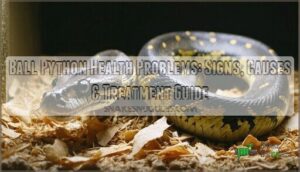This site is supported by our readers. We may earn a commission, at no cost to you, if you purchase through links.

Parasites, both internal and external, can stir up trouble, while poor habitat hygiene and nutrition add fuel to the fire. Spotting symptoms early and acting fast is the best way to keep your scaly companion thriving.
Proper care, clever prevention, and timely treatment are your secret weapons—there’s more to unravel about keeping your ball python healthy.
Table Of Contents
- Key Takeaways
- Common Ball Python Health Problems
- Signs Your Ball Python is Sick
- Parasites and Infections in Ball Pythons
- Preventing Ball Python Health Issues
- Treating and Managing Health Problems
- Frequently Asked Questions (FAQs)
- Do ball pythons have health problems?
- How can you tell if a ball python is sick?
- Are scaleless ball pythons dangerous?
- Are ball python bites dangerous?
- Do ball pythons have health issues?
- How to tell if ball python is unhealthy?
- How to know if a snake is ill?
- What are the signs of neurological problems in ball pythons?
- How often should ball pythons visit a vet?
- What are signs of a healthy ball python?
- Conclusion
Key Takeaways
- Respiratory infections and improper humidity are leading dangers for ball pythons, so careful control of their environment is essential. – Early signs of illness—like changes in appetite, activity, shedding, or unusual discharge—should trigger swift action and a vet visit. – Internal and external parasites, as well as bacterial and fungal infections, can thrive in unclean enclosures and quickly harm your snake’s health. – Preventing problems with strict quarantine, regular cleaning, habitat management, and annual checkups is the best way to keep your ball python thriving.
Common Ball Python Health Problems
Ball pythons run into a few health problems that every keeper should know about early on.
Let’s break down some of the most common issues you might spot—and what they mean.
Respiratory Infections and Their Causes
Respiratory infections represent the most serious health threat your ball python will face, and poor husbandry is the number one culprit. When temperatures drop or humidity sits outside the ideal range, your snake’s immune system weakens, opening the door to bacterial pneumonia and viral invaders like ball python nidovirus.
Disease progression can be swift—infected pythons develop mucus buildup, open-mouth breathing, and lethargy as inflammation damages lung tissue. One common symptom is nasal discharge, which owners should monitor closely. Without intervention, mortality rates climb above 10%, which is why environmental factors matter so critically to snake health.
Dysecdysis (Shedding Issues)
While respiratory infections can devastate your ball python’s health, shedding problems often serve as your first warning sign that something’s wrong with their environment. Dysecdysis—difficulty shedding—happens when humidity levels drop below 50-60%, causing the shedding cycle to stall. Recognizing signs early prevents complications:
- Retained eyecaps clouding vision
- Patchy, abnormal shedding instead of one piece
- Prolonged shedding frequency beyond 14 days
- Constricted circulation from skin rings
Supplementation impact matters less than environmental control here.
Dermatitis and Skin Irritation
When your ball python’s skin starts showing red, inflamed patches or blister-like lesions, you’re likely dealing with dermatitis—a bacterial or fungal skin infection that thrives in cages that are too damp, too dirty, or both. Scale rot and blister disease represent two forms of this reptile health nightmare.
You’ll need to address humidity levels immediately—aim for that 50-60% sweet spot—and implement rigorous hygiene practices. Remove soiled substrate daily, disinfect surfaces weekly, and improve ventilation.
Your vet may prescribe topical treatments or systemic antibiotics for severe cases, but wound care starts with environmental correction.
Dental Disease and Stomatitis
Infectious stomatitis—commonly called mouth rot—shows up as inflamed gums, cheesy yellow discharge, or pinpoint hemorrhages around your ball python’s mouth, and it’s one infection you can’t afford to ignore.
Bacterial overgrowth drives this oral infection, often triggered by:
- Immune suppression from stress or poor husbandry
- Mouth injuries from cage trauma or prey strikes
- Underlying respiratory disease spreading to oral tissues
Veterinary care with systemic antibiotics and antiseptic mouth rinses represents your treatment pathway—preventative care through proper temperatures and oral hygiene monitoring beats sophisticated treatment every time.
Metabolic Bone Disease
Most keepers don’t realize calcium deficiency can cripple juvenile reptiles within months—and ball python health depends on getting UVB lighting, dietary phosphorus ratios, and supplementation right from day one.
Bone demineralization occurs when your snake’s calcium-to-phosphorus balance tips wrong, triggering skeletal weakening, jaw deformities, tremors, and spontaneous fractures.
Snake health issues like MBD demand immediate veterinary care: correcting diet, adding proper UVB exposure, and administering calcium supplements offer your best shot at recovery, though severe cases may leave permanent damage. This is because a prolonged lack of vitamin D3 can lead to metabolic bone disease.
Signs Your Ball Python is Sick
Catching health problems early can mean the difference between a quick fix and a critical emergency.
Here are the key warning signs that tell you something’s wrong with your ball python.
Lethargy and Loss of Appetite
If your ball python suddenly seems less interested in dinner or spends all day hiding in the same corner like a recluse avoiding Thanksgiving, you might be looking at the first red flags of illness. Identifying lethargy means watching for reduced movement, weak muscle tone, and zero interest in exploring—classic snake disease symptoms.
Causes of anorexia range from stress and improper temperatures to parasites and infections. Hydration importance can’t be overstated either, since dehydration compounds snake health issues fast.
Unusual Shedding or Skin Lesions
When your ball python’s shed comes off in patches instead of one smooth tube, or you spot raw, crusty, or discolored areas on their skin, something in their environment—or their body—has gone wrong.
Abnormal shedding often signals humidity issues, while skin infections like scale rot and blister disease create red, weeping lesions that can develop into abscesses requiring treatment.
Scar tissue from old wounds may affect shedding frequency, and dermatitis spreads fast if you don’t address snake health issues immediately.
Discharge or Bleeding From Eyes, Nose, or Mouth
A clear, mucus-like discharge bubbling from your ball python’s nostrils—or worse, blood-tinged fluid pooling near their mouth—isn’t just concerning; it’s your snake waving a red flag that screams respiratory infection, stomatitis, or even systemic disease. Snake disease symptoms like these demand immediate veterinary intervention because discharge causes and bleeding significance vary dramatically:
- Respiratory infections produce bubbling mucus and labored breathing
- Stomatitis creates bloody, cheese-like discharge around the mouth
- Septicemia causes systemic bleeding and lethargy
Identifying discharge early and securing treatment options from your veterinarian can mean the difference between recovery and tragic decline in snake health.
Changes in Stool or Urine
Your ball python’s waste tells a story—one that reveals hidden parasites, dehydration, kidney failure, or digestive disasters before other symptoms even surface. Healthy stool consistency should be brown, semi-solid, and accompanied by white urate.
Watch for these snake health issues:
| Finding | Possible Cause | Action Required |
|---|---|---|
| Yellow/green urates | Dehydration signs or kidney function problems | Increase humidity; see veterinarian |
| Watery stool | Diarrhea causes: parasites, gastrointestinal disease | Fecal exam needed |
| Blood in waste | Internal bleeding or severe infection | Emergency vet visit |
| No urates | Kidney failure | Immediate veterinary care |
| Foul odor | Bacterial infection | Schedule exam |
Snake symptoms like urate changes demand quick assessment of your snake health.
Abnormal Behavior and Body Language
Snakes don’t complain, cry, or limp—they mask pain and distress with subtle shifts in posture, movement, and routine that most owners miss until it’s almost too late. Hiding excessively or glass surfing signals stress, while erratic movements and unusual aggression often point to neurological symptoms.
Regurgitation frequency increases with illness, and lethargy paired with loss of appetite screams snake health crisis. Learn your python’s baseline behavior—deviations are your earliest warning system for detecting snake symptoms before they escalate.
Parasites and Infections in Ball Pythons
Parasites and infections can strike even well-cared-for ball pythons, and catching them early makes all the difference.
Here are the usual troublemakers to keep an eye out for—and what to do if your snake runs into them.
Internal Parasites and Their Symptoms
Internal parasites pose a hidden threat that can devastate your ball python’s health before visible symptoms appear. Up to 45% of captive snakes harbor these invaders, making awareness critical. Watch for these warning signs:
- Gastrointestinal distress — diarrhea, mucus or blood in feces, regurgitation
- Systemic manifestations — lethargy, weight loss, emaciation, dehydration
- Ocular signs — swollen eyes, cloudy fluid under spectacles
- Respiratory symptoms — open-mouth breathing, mucus discharge
- Sudden death — even without prior symptoms in severe cases
Fecal-oral transmission through contaminated enclosures remains the primary risk factor, especially in co-housed snakes or facilities with poor hygiene.
External Parasites and How to Treat Them
While internal parasites work their damage from within, external parasites—mainly mites and ticks—announce themselves on the surface, where you can spot them with a careful eye.
Mite identification starts with checking scale creases and around the eyes for tiny black or red dots that move. Ticks appear as gray bumps attached to skin.
For snake treatment, remove ticks manually with tweezers, then address mites with veterinarian-approved acaricides. Scale mites left untreated can cause blister disease.
Preventative measures include quarantining new snakes and maintaining rigorous cleaning protocols.
Bacterial and Fungal Infections
Beyond the visible threats of mites and ticks, bacterial and fungal infections strike deeper—sometimes fatally. Bacterial infections hit 12.8% of captive males in surveyed colonies, with common pathogens like Providencia rettgeri and Pseudomonas aeruginosa causing respiratory disease and septicemia.
Snake fungal disease (SFD) carries a grim 40% mortality rate, while infection prevalence for serpentovirus reaches 37.7% across collections. Husbandry factors—poor humidity control, unsanitary conditions—fuel these outbreaks.
Diagnostic methods include skin biopsies, cultures, and PCR testing for accurate identification and targeted snake disease treatment.
Preventing Ball Python Health Issues
Staying ahead of problems is key—you want your ball python to stay healthy before any issues even have a chance to show up.
Here’s how to keep your snake healthy from day one by addressing quarantine, habitat management, hygiene, and veterinary care.
Quarantine and Biosecurity for New Snakes
Quarantine is your best early safeguard. It’s a simple step, but it can spare you months of treating sick snakes and help you avoid some real heartbreak.
Keep any new snake in its own room with its own gear for at least 90 days to stop disease from jumping between animals.
Essential quarantine protocols include:
- Using separate tools and feeding equipment for quarantining snakes
- Washing hands thoroughly between interacting with different animals
- Monitoring daily for mites, respiratory symptoms, and feeding response
- Scheduling veterinary screening within the first two weeks
Poor hygiene during this period undermines your entire biosecurity effort, so treat isolation seriously—your existing collection’s snake health depends on it.
Proper Cleaning and Disinfection
Your enclosure’s cleanliness isn’t just about aesthetics—it’s a direct shield against bacterial, fungal, and parasitic threats that capitalize on filth to colonize your ball python’s vulnerable systems.
Establish a cleaning schedule that includes daily spot-cleaning and weekly disinfection using reptile-safe products. Chlorhexidine or F10SC disinfectants work well for enclosure materials without compromising snake health.
Don’t overlook water sanitation—contaminated bowls breed pathogens faster than you’d think, undermining your entire snake husbandry routine.
Habitat Setup and Environmental Control
A ball python’s habitat isn’t just a glass box—it’s a complex life-support system where temperature gradients, humidity levels, and substrate choices directly determine whether your snake thrives or slowly deteriorates from preventable stress-induced illness.
Maintain a thermal gradient of 88–92°F basking and 78–80°F cool side within an appropriately sized enclosure—juveniles need 10–20 gallons, adults require 40+ gallons minimum.
Humidity control between 50–60% prevents dysecdysis, while proper substrate choices and lighting needs encourage natural behaviors without fostering bacterial growth.
Importance of Regular Veterinary Check-Ups
Routinely scheduling Ball Python Veterinary Care isn’t just a box to tick—it’s your best defense against snake health issues. Early illness detection during annual exams means you’ll spot snake disease symptoms before they snowball, boosting lifespan and reducing costs long-term.
Following professional standards for preventative benefits, a qualified veterinarian helps guarantee your python’s health and disease risks stay firmly under control.
Treating and Managing Health Problems
When your ball python runs into health trouble, knowing what to do next matters just as much as spotting the first signs.
Here’s what to keep in mind when treating and managing the most common problems.
Dysecdysis Treatment and Prevention
Ever seen a snake go through a bad shed and wonder if it’s clinging to its old skin like an awkward sweater that just won’t come off? When dealing with dysecdysis, keep these essentials in mind:
- Boost humidity levels—think rainforest, not desert. – Offer safe soaking techniques. – Use gentle shedding aids. – Maintain strict enclosure hygiene and consult a vet when persistent shedding problems signal deeper reptile health or snake health issues tied to environmental factors.
Respiratory Infection Treatment
When a ball python starts wheezing or bubbling at the nose, it’s a red flag that demands quick, calm action. Immediate Veterinary Care is essential—don’t wait. Beneficial Care, Humidity Control, and Nebulization Therapy help stabilize respiratory disease. Your vet may prescribe Antibiotic Options designed for snake health and disease. Here’s a quick treatment overview:
| Step | Purpose | Example |
|---|---|---|
| Veterinary Care | Diagnosis | Cultures, X-rays |
| Antibiotic Options | Infection control | Enrofloxacin, Ceftaz |
| Humidity Control | Symptom relief | Mist enclosure |
| Nebulization Therapy | Airway assistance | Saline, meds |
Stomatitis and Dental Care
Did you know that a snake’s mouth can be a window into its overall health, revealing early clues of stomatitis long before other symptoms show up? Watch for swollen gums or excess mucus—classic signs of oral infections like mouth rot.
Early snake treatment involves antibiotic use, abscess treatment, and nutritional care. Oral hygiene and preventative care keep infectious stomatitis and other snake diseases at bay.
Emergency First Aid and When to Call a Vet
Spotting those early warning signs in your snake’s mouth is just the start—sometimes, quick action and a call to your vet can make all the difference between a close call and a real emergency.
If you notice snake symptoms like prolapse, trauma, toxin exposure, or seizures, apply basic wound care, follow snakebite treatment protocols, and contact your veterinarian immediately.
Frequently Asked Questions (FAQs)
Do ball pythons have health problems?
Curiously, Ball Pythons do face health problems—think IBD Impact, Genetic Predisposition, and Preventative Husbandry challenges.
Snake disease symptoms and veterinary costs can be overwhelming, sometimes leading to tough Euthanasia Decisions for common snake diseases.
How can you tell if a ball python is sick?
Imagine your usually curious python suddenly hiding nonstop or refusing food—early symptom recognition matters.
Watch for behavioral changes, appetite changes, physical indicators like skin lesions, and lethargy; these snake symptoms often signal reptile diseases needing veterinary diagnosis.
Are scaleless ball pythons dangerous?
Is a scaleless ball python a ticking time bomb? Not exactly, but Scaleless Genetics bring Skin Vulnerability, Infection Risk, and Breeding Concerns—raising Ethical Considerations in snake care.
Watch closely for pet snake diseases and snake disease symptoms.
Are ball python bites dangerous?
A nip from a ball python is rarely severe—think more of a startled pinch than a medical emergency.
Thanks to venom absence, the real concern is infection risk, especially Salmonella, so proper wound care and bite prevention matter.
Do ball pythons have health issues?
Ball pythons aren’t immune to health issues—think IBD concerns, genetic predisposition, and the impact on lifespan.
Preventative measures matter, especially with snake disease diagnosis and symptoms of Inclusion Body Disease, which sometimes require difficult euthanasia decisions.
How to tell if ball python is unhealthy?
Spot a ball python in distress and you’ll notice visual cues like abnormal shedding, weight loss, or skin lesions.
Additionally, behavioral changes—lethargy, loss of appetite, weaving, and odd eating habits—can signal symptoms of Inclusion Body Disease.
How to know if a snake is ill?
Ever notice your snake hiding more, refusing food, or shedding oddly? Behavioral changes, physical symptoms, appetite loss, abnormal shedding, or neurological signs like weaving all warrant prompt veterinary exams to catch illness before it worsens.
What are the signs of neurological problems in ball pythons?
When you notice head tilting, star gazing, corkscrewing, or incoordination, neurological symptoms may be at play.
Head tremors, seizures, lethargy, loss of appetite, and weaving often point toward Inclusion Body Disease or other neurological disorders.
How often should ball pythons visit a vet?
How often should you schedule a vet visit for your ball python? Aim for annual check-ups—think of it as a health monitoring schedule.
Preventative care is key, and choosing a qualified reptile vet helps safeguard animal health and your investment.
What are signs of a healthy ball python?
From time to time, the best indicator for animal health in your exotic pets shines through: clear, intact eyes, healthy skin, regular shedding, a consistent appetite, and normal behavior—never lethargy or unexplained weight loss.
That’s reptile care done right.
Conclusion
Samantha once thought skipping a meal was just “ball python stubbornness,” only to discover early signs of respiratory distress—a classic case of ball python health problems.
Keeping a close eye on symptoms, practicing sharp husbandry skills, and consulting with a reptile-savvy vet can mean the difference between a thriving python and a crisis.
Remember, knowledge is your best tool for spotting trouble, acting swiftly, and giving your ball python the healthy, vibrant life it deserves.
- https://www.frontiersin.org/journals/veterinary-science/articles/10.3389/fvets.2019.00338/full
- https://pmc.ncbi.nlm.nih.gov/articles/PMC4173777/
- https://www.sciencedirect.com/science/article/pii/S0042682217304130
- https://lafeber.com/vet/respiratory-disease-in-snakes/
- https://pubmed.ncbi.nlm.nih.gov/10065857/



















